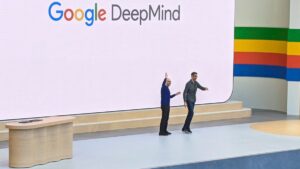DeepMind to Utilize AI Models for Enhancing Physical Robots

Google DeepMind’s New AI Models for Robotics
Introduction to Gemini 2.0
On Wednesday, Google DeepMind unveiled two innovative artificial intelligence (AI) models designed for robotics, powered by what the company describes as its "most capable" AI to date—Gemini 2.0. This leap in technology aims to transform how robots operate by enabling them to execute physical tasks, rather than merely generating textual or visual outputs. This marks a significant development in the integration of AI into real-world applications.
Partnership with Apptronik
To further its ambitions in humanoid robotics, Google has partnered with Apptronik, a robotics developer based in Texas. Apptronik has a strong history of working with notable organizations such as Nvidia and NASA, showcasing its expertise in the field. Recently, Google took part in a $350 million funding round for Apptronik, highlighting its commitment to pushing the boundaries of robotics technology with Gemini 2.0.
Demonstration of Capabilities
In video demonstrations released by Google, the Apptronik robots equipped with Gemini 2.0 AI showcased an impressive range of capabilities. They completed tasks like plugging appliances into power strips, preparing lunchboxes, and even zipping up bags, all in response to spoken commands. These examples illustrate the model’s potential for practical application, although Google has not yet provided a specific timeline for when this technology will be available to the public.
Key Features of Gemini Robotics
According to Google, AI models used in robotics must possess three essential qualities to be truly effective:
General Adaptability: The robots need to adapt to a variety of situations and environments, allowing them to perform diverse tasks.
Interactivity: They should respond quickly to instructions and changes in their surroundings, facilitating seamless human-robot interaction.
- Dexterity: The robots must have the ability to manipulate objects like humans do, using their hands and fingers for precise tasks.
Gemini Robotics-ER
Another addition to Google’s robotics initiative is Gemini Robotics-ER, which is designed as a training foundation for roboticists. This model is available not only to Apptronik but also to a select group of "trusted testers," which includes prominent organizations like Boston Dynamics and Agility Robotics. This approach fosters collaboration in developing further advancements in the field.
The Bigger Landscape in AI-Robotics
Google is not the only tech giant interested in integrating AI with robotics. Last November, OpenAI made headlines by investing in Physical Intelligence, a startup focused on creating general-purpose AI systems for robots. OpenAI has also been ramping up its involvement in robotics, even hiring experts from companies like Meta to advance its technology in this space.
Furthermore, Tesla has entered the humanoid robotics market with its Optimus robot, illustrating the competitive landscape of AI-driven robotics technology.
Google’s Vision for Robotics
Sundar Pichai, Google’s CEO, emphasized the role of robotics as a testing ground for translating AI advancements into tangible applications. He believes the multimodal AI models will allow robots to adapt and make real-time adjustments based on their environments, enhancing their utility in everyday tasks.
Overall, the developments at Google DeepMind signify a notable step forward in bringing AI technologies into the physical realm, with the potential to reshape industries and improve daily living. As advancements in technology continue, the expectations for AI’s capabilities in robotics will only grow, signaling exciting possibilities for the near future.






